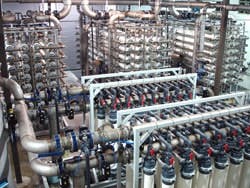Florida’s First Municipal UF Plant for Potable Water
| Related Searches from WaterInfoLink.com Ultrafiltration | Palatka, Florida | Layne Christensen |
Located 50 miles northwest of Daytona Beach, Fla., the 11,000 residents of the City of Palatka derive their potable water supply from groundwater through multiple wells with varying water qualities. Like many communities in Florida, Palatka’s relatively high water table is subject to the influence of surface water, which manifests itself as elevated organics in the raw well water. Any possibility of infection from these organics is neutralized through disinfection.
Disinfecting organics in water can, however, lead to other issues. Organics can react with disinfectants, forming carcinogenic disinfection byproducts (DBPs) in the form of trihalomethanes (THMs) and haloacetic acids (HAA5).
As early as 2003, Palatka’s commissioners were aware of impending regulatory changes, and that the city was likely to be non-compliant with the EPA’s lower DBP maximum contaminant levels. The commissioners took a proactive stance and planned for the necessary improvements to the R.C. Willis Water Treatment Plant. Assisted by a consulting engineer, Hoyle Tanner & Associates, the city selected a process of air stripping for H2S removal followed by oxidation, enhanced coagulation and then ultrafiltration (UF) for manganese and TOC removal. The city piloted a Norit membrane to remove the organics, and this configuration was used to bid the membrane portion of the project.
Layne Christensen Co. was selected as the system integrator for the 6-million-gal-per-day (mgd) primary UF system with Norit XIGA membranes for potable water production along with a 1-mgd secondary system with Norit Aquaflex membranes for backwash recovery. The membrane systems were fabricated entirely by Layne’s own forces at its 40,000-sq.-ft. fabrication facility in Lakeland, Fla.
The system was installed and commissioned in the fall of 2009. Based on the pilot data, the plant was configured for a coagulant dosage of 4 mg/L of alum. The plant’s performance has shown an average TOC reduction of 40%, and the four distribution system sampling points show an average DBP of 55.1 (well below the MCL of 80 µg/L), and all four measurement points are reporting below the MCL, thus achieving the city’s compliance goals for treatment of DBPs, H2S and manganese. The primary and secondary membranes run continuously, only requiring occasional chemically enhanced backwashes to maintain stable trans-membrane pressures, and do not require any offline cleanings.
